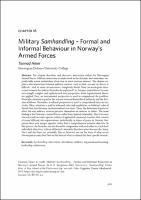Chapter 16 Military Samhandling
Formal and Informal Behaviour in Norway’s Armed Forces
| dc.contributor.author | Heier, Tormod | |
| dc.date.accessioned | 2018-10-08 13:13:20 | |
| dc.date.accessioned | 2020-04-01T12:20:20Z | |
| dc.date.available | 2020-04-01T12:20:20Z | |
| dc.date.issued | 2018 | |
| dc.identifier | 1001657 | |
| dc.identifier | OCN: 1076751277 | en_US |
| dc.identifier.uri | http://library.oapen.org/handle/20.500.12657/28305 | |
| dc.description.abstract | "The chapter describes and discusses interaction within the Norwegian Armed Forces. Military interaction is understood as the dynamic and sometimes unpredictable action undertaken when two or more services interact. The chapter explores why interaction between military services, such as land, sea and air forces, is difficult – and, in some circumstances, completely absent. How can inadequate interaction between the military branches be explained? As Europe’s armed forces become increasingly complex and sophisticated, two perspectives from organisational theory are applied. First, an instrumental perspective is used to comprehend the problem. Particular attention is paid to the tension between hierarchical authority and the division of labour. Thereafter, a cultural perspective is used to comprehend inter-service rivalry. Here, attention is paid to informal rules and regulations, or habitual ‘rules of thumb’ that have become institutionalised over time. These ‘the behavioural patterns’ affect the way military services perceive themselves in contrast to others. The main finding is that Norway’s Armed Forces suffer from ‘limited rationality’. This is because Norway’s military units operate within a fragmented command structure that consists of many different sub-organisations; individually, in times of peace in Norway, they pursue their own myopic agendas rather than a comprehensive national objective. In this process, the branches are also forced to compromise with each other to reach their individual objectives. A form of limited rationality therefore arises because the Army, Navy and Air Force act rationally. This is, however, not on the basis of what serves Norwegian security best, but on the basis of what is rational for their specific branch." | |
| dc.language | English | |
| dc.subject.classification | thema EDItEUR::J Society and Social Sciences | en_US |
| dc.subject.classification | thema EDItEUR::J Society and Social Sciences::JW Warfare and defence | en_US |
| dc.subject.classification | thema EDItEUR::J Society and Social Sciences::JW Warfare and defence::JWK Military and defence strategy | en_US |
| dc.subject.other | Samhandling | |
| dc.subject.other | interaction | |
| dc.subject.other | subcultures | |
| dc.subject.other | military | |
| dc.subject.other | organisational learning | |
| dc.subject.other | leadership | |
| dc.subject.other | unforeseen | |
| dc.title | Chapter 16 Military Samhandling | |
| dc.title.alternative | Formal and Informal Behaviour in Norway’s Armed Forces | |
| dc.type | chapter | |
| oapen.identifier.doi | 10.23865/noasp.36.ch16 | |
| oapen.relation.isPublishedBy | bf7b42a4-6892-42e3-aaf8-8f32c8470a8b | |
| oapen.relation.isPartOfBook | 2724fb8b-60f0-4a89-9f93-98ba00ad6223 | |
| oapen.pages | 18 | |
| oapen.place.publication | Oslo | |
| oapen.identifier.ocn | 1076751277 |

